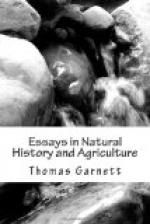“We were for several years, but I do not know the dates, entirely without Salmon, and of course without Smolts; and we invariably found that the Smolts made their appearance the year after the Salmon, but were very small till the second year, when we had what we call blue Smolts, which disappeared in May or June; and what you called Pinks, which remained till the following year; and Brambling Smolts, which remained another year. The fishermen here are also of opinion that neither Salmon nor Trout spawn every year. Robinson says that one day lately (the letter is dated December 13th) he caught seven Trouts, six of which were in good season; and he brought me two the other day, one of which contained roe, and the other was in excellent condition.” My friend states, in a subsequent communication, that one of the fishermen had told him that he had caught the male Smolt (Par) more abundantly on the Salmon spawning beds than elsewhere, and my friend adds that the opinion there is, that if a female Salmon gets up to the spawning beds, and if no male accompanies her, yet her eggs are fecundated by the male Smolts; and they allege, in support of this opinion, that a female got up one season and spawned, and though no male was seen near her her eggs were prolific. I mention this, although I apprehend it is evidence which the unbeliever will consider inadmissible, for though no male was seen, still there may have been one, or admitting that one did spawn, without being accompanied by a male, yet another, which contrived to bring her mate along with her, may have spawned in the same place the same season; yet, notwithstanding its liability to these objections, I have no doubt myself that if a female were to come alone her eggs would be impregnated by the Par. It is an excellent maxim, that Nature makes no useless provisions; yet, if we admit that Par are young Salmon, for what purpose is the milt if not to impregnate Salmon roe? and if we deny this to be the fact, we must endeavour to show that there are female Par, but in all my examinations, I have never been able to meet with one that contained roe. That the Grilse are Salmon is proved I think sufficiently by the evidence given before the House of Commons. Mr. Wm. Stephens states (see Rep., p. 52) that he has known Grilse kept in a salt-water pond until they became Salmon, and that fry that had been marked came back that year as Grilse, and the year after as Salmon; and Mr. George Hogarth states that he has often seen a Salmon and a Grilse working together on the spawning beds, as two Salmon, or two Grilse; and Mr. Mackenzie states (page 21) that he, in March, 1823, marked a Grilse Kelt with brass wire, and caught it again in March, 1824, a Salmon of seven pounds weight. The testimony of the witnesses from the Ness, the Severn, the Lee, and some other rivers, is too positive and too well supported to admit of any doubt as to the excellent condition of many of the fish ascending those rivers in November, December, and January—a




